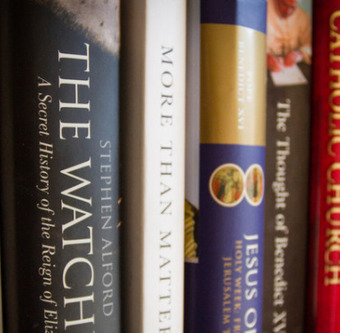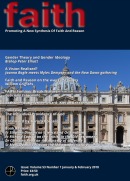
Book Review - Science and Original Sin
Evolution and the Fall,
ed. William T. Cavanaugh and James K. A. Smith, Eerdmans, xxix + 231pp, £21.99.
reviewed by Stephen Dingley
Evolution and the Fall is a collection of essays from a multi-disciplinary and ecumenical group of authors, which sets out to address “a set of problems that arise from the encounter of traditional biblical views of human origins with contemporary scientific theories” (p. xv) —not, one might add, in general, to answer them. Only two of the contributors attempt synthetic solutions to the problems. That said, I found all the chapters worthwhile and stimulating —even when I disagreed with them.
Three of the chapters provide the data. Falk gives an admirably clear review of the current scientific consensus. Examining the fossil record, he outlines human ancestry and its dating. Genetic evidence offers impressive support for human evolution and also strongly suggests that our ancestral population has never been smaller than about 10,000, ‘Mitochondrial Eve’ and ‘Y-chromosome Adam’ notwithstanding. In fact, each human gene can be traced back to a single ancestor at some point over the last few million years, but different individuals at different times, and this is entirely to be expected statistically.
Interpreting Genesis
Middleton offers an exegesis of Genesis 1–3 and, by his own admission, not much more. His methodological remarks are sound and helpful: Genesis is an ancient and non-scientific narrative, so we should look for consonances (and perhaps collisions) with the scientific data rather than attempting any detailed concordism. He suggests that God breathing life into the man of dust (Gen 2:7) can be likened to the ‘vivification’ of a pagan cultic image, and has “nothing to do with infusing a Platonic soul” (p. 75) —a statement which seems too strong to me. Green examines some inter-testamental literature, as well as Paul and James from the New Testament. He concludes that both Paul and James “assume sin’s heritability — not in the sense of passing sin down through procreation, but in the sense of pattern and influence” (p. 115), but I found it hard not to think this was in fact Green’s assumption.
I would have appreciated some discussion of the contribution of Tradition on these questions, especially St Augustine’s views, which just get a few rather disparaging mentions. And since recent papal teachings are discussed, the dogmas of the Council of Trent surely also deserve some consideration.
A real Adam?
Of the more speculative contributions, I liked Smith’s chapter, “What stands on the Fall?” (nice pun). He points out that only an event-like Fall can guarantee the goodness of God and authentic hope for salvation; otherwise God must have created our sinful condition, and salvation must be contrary to our created nature. I was even more impressed with Riches’ Christological insight that Adam must be a concrete individual, not merely a mythical figure. Christ, precisely as incarnate Son of the Father, reveals that the meaning of man is only found in real, interpersonal relationships — and a myth cannot have real relationships. Only a real Adam who commits a historical sin can be the protagonist of humanity and prefigure Jesus as New Adam and Saviour.
I was disappointed that both Deane-Drummond and Smith — the only two authors to attempt a synthesis — assume, without clear justification, that the biological evidence excludes a single, historical Adam who commits a single, historical sin. (Smith suggests a historical Fall in the sense of the whole population of some 10,000 individuals all sinning over an extended period of time.) I was more disappointed that none of the ten authors consider the infusion of a spiritual soul as the unique mark of man — which could offer a way to reconcile a wider population with a real, unique first human couple.
How we see the fallen world
A number of the essays focus on methodological and contextual issues. Cavanaugh points out that the Fall had been dropped from early Modern thought not for any scientific reasons but for political expediency — to protect civil authority from interference by the Church. Wirzba explores the role of hermeneutics: when we look at the world, what we actually see depends on our perspective. Thus, seeing the world as fallen is not obvious. A ‘Darwinian’ perspective of randomness and struggle cannot see the world as fallen because it cannot see God as the goal of creation. (Wirzba briefly acknowledges that this perspective goes well beyond what Darwin’s science actually warrants.) Maximus the Confessor, on the other hand, offers a Christological perspective in which the Fall makes good sense. How one might choose between such perspectives is not, however, considered.
The science and God question
The concluding chapter is one of the best in my estimate—although I still did not agree with everything. Harrison proposes that some conflict between religion and science can actually be a good thing, illustrating this inter alia with the question of whether the universe has always existed: Aristotle’s ‘scientific’ view that it has always existed conflicting with the theological position that it was created a finite time ago, which latter view has now been vindicated by the Big Bang theory. The point is well made, but this is dangerous territory. Multiverse theory (now quite mainstream science) challenges the idea that the Big Bang was in fact the beginning of everything; then again, thermodynamics and the Borde-Vilenkin-Guth theorem suggest that there must have been some beginning of everything only a finite time ago. Harrison notes the variability of scientific opinion over time and the fact that different scientific theories have different levels of certainty, but he — and several other authors in this book—seem rather too pessimistic: “in the long historical view, [science] gets most things wrong” (p. 225).
Harrison also unfolds Augustine’s insightful contribution to the science–religion debate, drawing out a number of valuable principles — not least, recommending restraint where issues are not clear, and avoiding bringing Christianity into contempt by arguing for false scientific opinions on the supposed grounds of scriptural warrant. Augustine also thinks that pursuing some scientific questions can be mere idle curiosity and a distraction from the more serious moral and religious purpose of human life. Harrison inclines to the view that this might apply to the questions raised by this book. I am again more optimistic than he is. If the myth that science has disproved God is a major factor in the decline of religious and moral life in the West — and I think it is — then resolving these questions convincingly is a major pastoral and evangelical priority.
Notes:
Fr Stephen Dingley is senior lecturer in theology at St John's Seminary, Wonersh.





